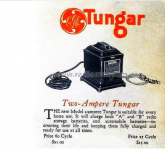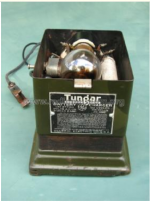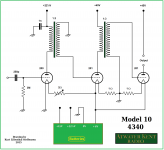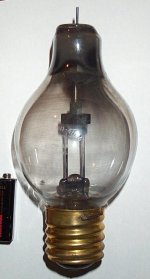I have recently restored a Tungar Bulb Charger. It is working great. This model was used not only to charge car batteries but was used as a Tube Radio battery eliminator. I have the 2A model. It has multiple taps.
Tungar Battery-Charger for A and B Power-S General Electric
My question is, if I use this as a battery eliminator what kind of filter would I need to create? Given that it has a high current output does that mean I can use modern high value filter caps?
If I use it as a Battery Charger would I still need to filter it if I intend to add a charger cutoff circuit to protect the battery?. I know many chargers use pulsing DC, but will the circuit linked below have an issue with that?
12v Automatic Charger (Auto Cut OFF) : 3 Steps (with Pictures) - Instructables
I don't really have a plan for what I intend to build, but I do intend to use it one way or another.
The charge cut off schematic uses 1N4007 diodes, could they be replaced with tubes? The Transistor?
I could also use it to supply field coil voltage as in this thread:
Tungar Power Supply
Would I still need a Power Transformer given that the unit already has a power transformer built in? Looks like the circuit in the thread used just the bulbs. I have read the charger can still be unsafe as is.
I'm looking for advice and suggestions on how I could make this restored charger useful for some project in the future.
Tungar Battery-Charger for A and B Power-S General Electric
My question is, if I use this as a battery eliminator what kind of filter would I need to create? Given that it has a high current output does that mean I can use modern high value filter caps?
If I use it as a Battery Charger would I still need to filter it if I intend to add a charger cutoff circuit to protect the battery?. I know many chargers use pulsing DC, but will the circuit linked below have an issue with that?
12v Automatic Charger (Auto Cut OFF) : 3 Steps (with Pictures) - Instructables
I don't really have a plan for what I intend to build, but I do intend to use it one way or another.
The charge cut off schematic uses 1N4007 diodes, could they be replaced with tubes? The Transistor?
I could also use it to supply field coil voltage as in this thread:
Tungar Power Supply
Would I still need a Power Transformer given that the unit already has a power transformer built in? Looks like the circuit in the thread used just the bulbs. I have read the charger can still be unsafe as is.
I'm looking for advice and suggestions on how I could make this restored charger useful for some project in the future.
Is it one of these, just shy of 100 years old? Maybe you could mention it on the 100 year ld amplifier thread, since it has its place there, making it possible for everyone to have a common source of power - a battery.
Looking at the ad they had a 25Hz version, so I presume that would be some old generator in the back of beyond.
Wouldn't it be nice to find a companion radio for it? There are quite a lot of 50's portable radios that would use standard B and C voltages, or find some old radio with a horn speaker! I would pay money to listen to something coming out of that setup.
Looking at the ad they had a 25Hz version, so I presume that would be some old generator in the back of beyond.
Wouldn't it be nice to find a companion radio for it? There are quite a lot of 50's portable radios that would use standard B and C voltages, or find some old radio with a horn speaker! I would pay money to listen to something coming out of that setup.
Attachments
As it happens when a local radio repair shop closed down due to the owner departing to that "great wireless in the sky " I was able to buy some of his stock as sold by his son .
One item is a Tungar "Battery Charger Valve " --its massive !
I also have original "battery eliminators " for valve radios but there are circuits for making a modern replacement.
Its quoted at 6 amps and still boxed made by Ediswan -The Ediswan
Electric Co Ltd Ponders End Middlesex
One item is a Tungar "Battery Charger Valve " --its massive !
I also have original "battery eliminators " for valve radios but there are circuits for making a modern replacement.
Its quoted at 6 amps and still boxed made by Ediswan -The Ediswan
Electric Co Ltd Ponders End Middlesex
Its a lovely looking radio ,its a TRF design but no reaction control (UK speak ) - no regeneration ( US ) which means its not at all sensitive and requires a VERY long aerial.
You do know there are Seven versions of that model and the three tube version is the smallest ?
Antique Radio Forums • View topic - Atwater Kent Model 10
Its rare.
You do know there are Seven versions of that model and the three tube version is the smallest ?
Antique Radio Forums • View topic - Atwater Kent Model 10
Its rare.
I’m not sure how tungar rectifiers would handle filter caps. Lead acid batteries like ac ripple, you won’t find caps even in modern battery chargers.
Modern battery chargers aren't linear anymore though, but microprocessor controlled switching systems. They make clean enough DC to run an inverter directly, too
Unless you get a really cheap POS that is.
Just like today, there are dozens/hundreds of models of "battery charger". You are going to have to figure out exactly what you have.
Battery chargers like these would typically NOT be isolated from the line. Touching the output can give you a shock. Deadly; but remember our ggg-grandfathers faced runaway horses, wood brake shoes, overhead drive belts in factories, and 1918 Flu (and there was a war on); electrocution was just another risk.
In those days we charged lead/acid batteries with a large current (limited by charger resistance/heat) until the acid boiled. (Maybe a hygrometer to stop just before boiling.) Today's lead/acid batteries will not take much of this treatment. But adding a microprocessor to a Tungar is really strange.
Often there was no voltage control. Charging one 2V cell from 110V was inefficient (heat, electric bill) so you liked to stack-up several customers' batteries to 50-70 Volt nominal.
I have never seen a proper rechargeable "B+" battery. Too many cells!!!! Remember we did not have modern plastic cases and one-shot molding. (The 28V airplane tubes and later 12V tubes are a different class, and long after use of Tungars.)
25 Hertz was common for large machines (and their generating plants) before improved Silicon Steel. Niagara Falls ran 25Hz from 1886 to 2006. Large parts of upper NY state, and several other clusters, had 25Hz in offices and even in homes to mid-century. 25Hz (a bigger transformer) was a routine added-cost option on PA amplifiers and fancy radios up until WWII.
https://ieeexplore.ieee.org/ielx5/8014/4408514/04412948.pdf
Battery chargers like these would typically NOT be isolated from the line. Touching the output can give you a shock. Deadly; but remember our ggg-grandfathers faced runaway horses, wood brake shoes, overhead drive belts in factories, and 1918 Flu (and there was a war on); electrocution was just another risk.
In those days we charged lead/acid batteries with a large current (limited by charger resistance/heat) until the acid boiled. (Maybe a hygrometer to stop just before boiling.) Today's lead/acid batteries will not take much of this treatment. But adding a microprocessor to a Tungar is really strange.
Often there was no voltage control. Charging one 2V cell from 110V was inefficient (heat, electric bill) so you liked to stack-up several customers' batteries to 50-70 Volt nominal.
I have never seen a proper rechargeable "B+" battery. Too many cells!!!! Remember we did not have modern plastic cases and one-shot molding. (The 28V airplane tubes and later 12V tubes are a different class, and long after use of Tungars.)
25 Hertz was common for large machines (and their generating plants) before improved Silicon Steel. Niagara Falls ran 25Hz from 1886 to 2006. Large parts of upper NY state, and several other clusters, had 25Hz in offices and even in homes to mid-century. 25Hz (a bigger transformer) was a routine added-cost option on PA amplifiers and fancy radios up until WWII.
https://ieeexplore.ieee.org/ielx5/8014/4408514/04412948.pdf
Around 1950 I worked as a 'grease monkey' is a auto service station. We did a lot more than sell gas. Some of those Tungar based rectifiers were still being used to charge batteries altho copper oxide & selenium were common.
The Tungar rectifier is really 'brute force', it is half wave so the transformer needs to be gaped to allow for DC in the field.
Tungar is short for Tungsten Heater & Argon gas in the bulb.
The Tungar rectifier is really 'brute force', it is half wave so the transformer needs to be gaped to allow for DC in the field.
Tungar is short for Tungsten Heater & Argon gas in the bulb.
Attachments
Another point to stress is that like all gas rectifiers the tube has to conduct into something that will limit the peak current. When conducting the plate curve is vertical to negative, the unlimited current will soon destroy the cathode. The heater transformer can be setup as an auto transformer with lots of leakage reactance. That effectively limits the peak current while conducting.
If the Tungar ran straight into a battery the results would not be good.
If the Tungar ran straight into a battery the results would not be good.
- Status
- This old topic is closed. If you want to reopen this topic, contact a moderator using the "Report Post" button.
- Home
- Amplifiers
- Tubes / Valves
- GE Tungar Battery eliminator / Charger



